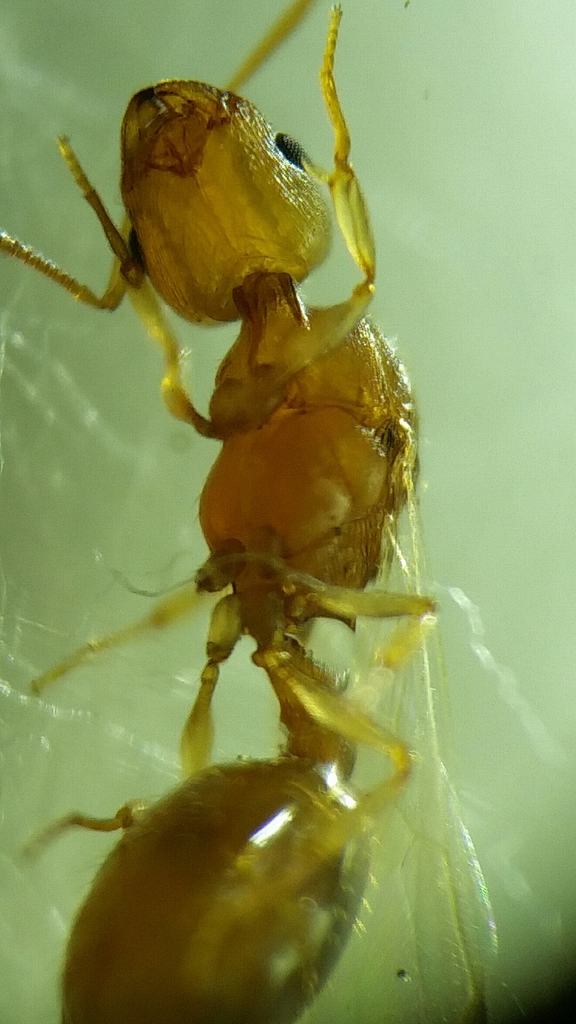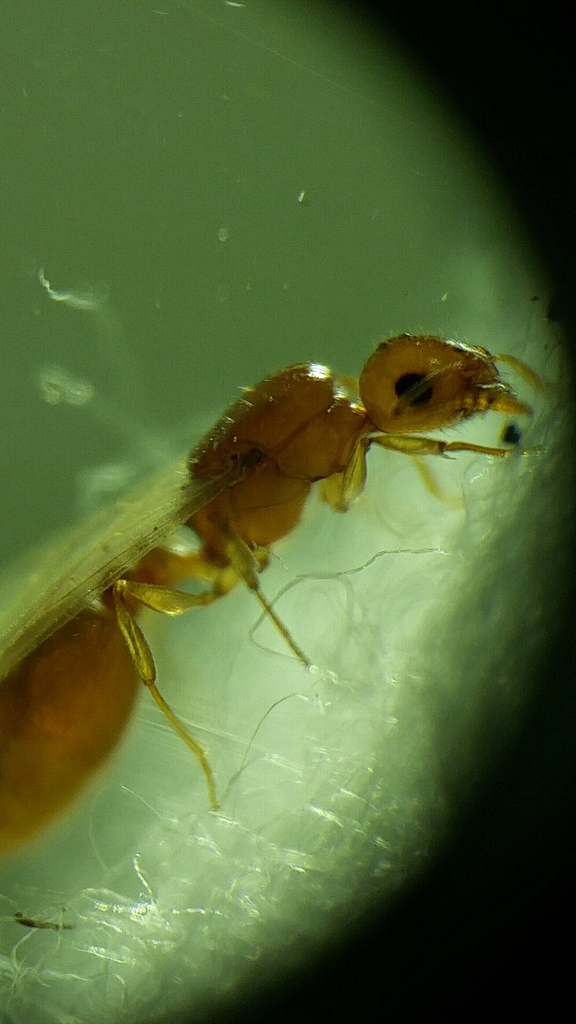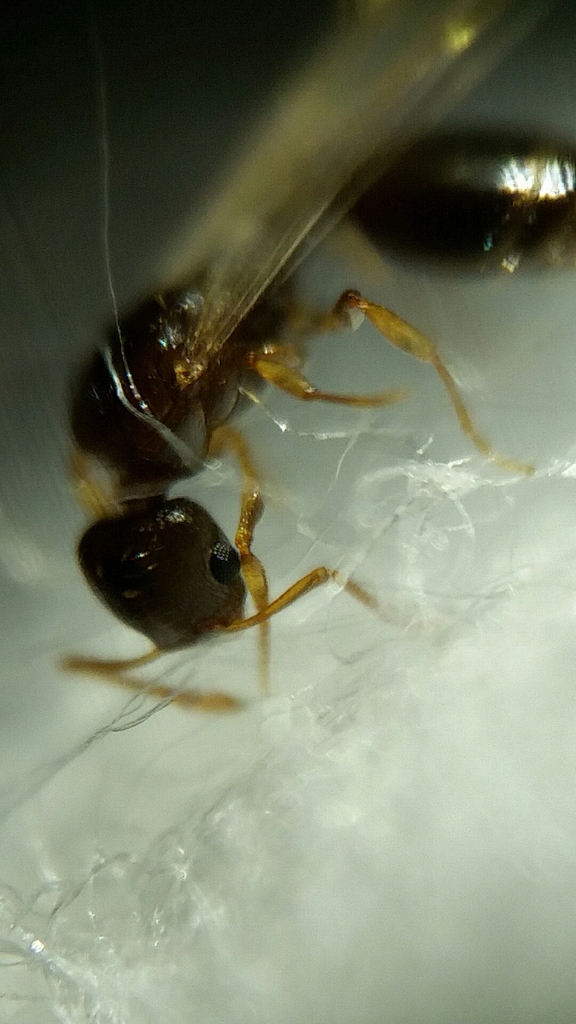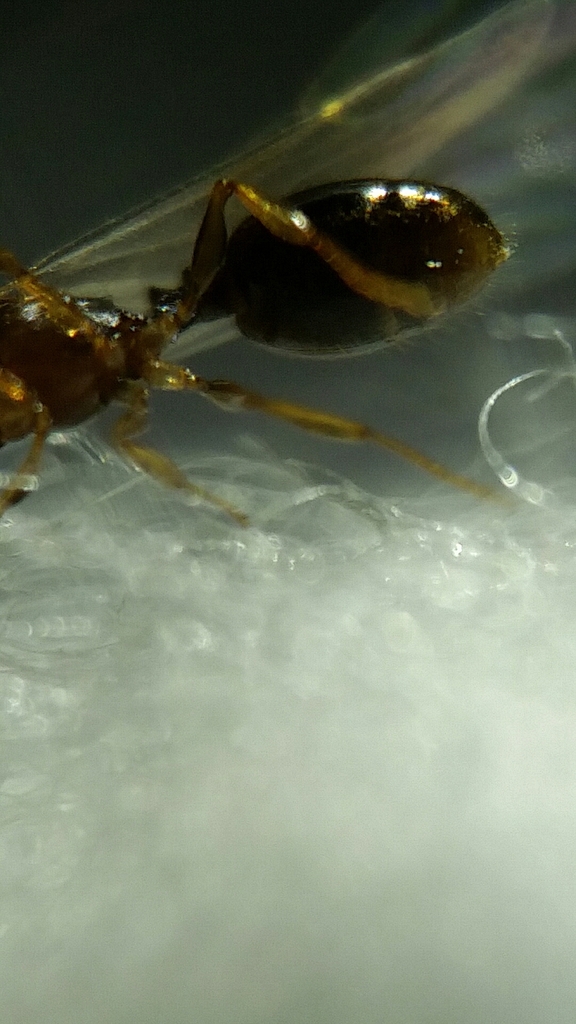nice colony!!!!!!!! ![]()
![]()
- Formiculture.com
- Forums
- Gallery
- Members
- Member Map
- Chat

nice colony!!!!!!!! ![]()
![]()
This colony is thriving, and seem to be continuing on with their ambiguous hibernation pattern. The queen laid a bunch more eggs, and they show no sign of slowing down.
They have an absolutely MASSIVE larva right now, along with a few very large pupae, and I may have been wrong in assuming the workers will not get larger. Sadly, the pupae do seem to be of the distinctly bicolored coloring which I am slightly less fond of.
I will upload some pictures later.
I'm also curious about just what size this colony will max out at. Recently, they have been stagnant, as some of the older workers have been dying (remember, this colony is over a year old now), and the new workers are just enough to replace them. I am hoping for around 150-175 workers, as that will nicely fill up one of the same type of formicariums as my Solenopsis and Hypoponera are in. I would make actually tunnels, instead of it being flat for them though.
Hi there! I went on a 6 month or so hiatus, in part due, and in part cause of the death of my colonies.
However, I went back to the Sierras, and restarted my collection, which is now as follows:
Aphaenogaster uinta, Camponotus vicinus, Camponotus modoc, Formica cf. aserva, Formica cf. micropthalma, Formica cf. manni, Formica subpolita, Formica cf. subaenescens, Lasius americanus, Manica invidia, Pogonomyrmex salinus, Pogonomyrmex sp. 1, Solenopsis validiuscula, & Solenopsis sp. 3 (new Sierra variant).
The worker eclosed!
These pictures do not do it justice, it absolutely DWARFS all the other workers in the colony.
Also, I observed a behavior I had never seen before: the workers of the colony were feeding this large worker before it even eclosed! It's gaster was the size it is now at the time it eclosed, which is quite incredible. I hypothesize that for this species, that is the purpose of these workers. It would certainly explain why I didn't see them in the wild. All of these new workers have larger, even undistended, gasters than the prior caste. I assume that they will make smaller workers as well; if not, then all these hypotheses go out the window. And I'm really hoping that other pupa doesnt darken much further. I want more orange workers.
Anyway, here are the unjust pictures:
Edited by NickAnter, December 29 2021 - 7:47 PM.
Hi there! I went on a 6 month or so hiatus, in part due, and in part cause of the death of my colonies.
However, I went back to the Sierras, and restarted my collection, which is now as follows:
Aphaenogaster uinta, Camponotus vicinus, Camponotus modoc, Formica cf. aserva, Formica cf. micropthalma, Formica cf. manni, Formica subpolita, Formica cf. subaenescens, Lasius americanus, Manica invidia, Pogonomyrmex salinus, Pogonomyrmex sp. 1, Solenopsis validiuscula, & Solenopsis sp. 3 (new Sierra variant).
So cute.
Favourite Genus: Polyrhachis
Instagram: australian_polyrhachis
May God Bless you.
Here is a video of them.
This colony has continued to be awesome. They probably peaked at over 100 workers, but recently about 30 have died, so they are a bit below 100 now. I think this is perfectly normal, as the deaths have pretty much stopped. They have many, many larvae, around 100, and I will increase feeding to hopefully get them to grow. They got 3 absolutely gargantuan pupae, of workers that would be near to the size of the queen, but much to my dismay these were eaten for some reason.
Their feeding responses have been getting better and better, and the workers show quite the aggression at intruding things. Also, as usual, they have no problem with going without food for a couple weeks, their food storage is really quite great. They also still have a beautiful array of different colored workers, possibly making them my favorite colony. They are my 3rd oldest as well, behind the Lasius, and the Nylanderia (Yes, those are alive, and thriving despite serious neglect. They don't really have much interesting happening, aside from a night-long escape after I unplugged by accident a vinyl tube when I fed them. They have several hundred workers still.)
Hi there! I went on a 6 month or so hiatus, in part due, and in part cause of the death of my colonies.
However, I went back to the Sierras, and restarted my collection, which is now as follows:
Aphaenogaster uinta, Camponotus vicinus, Camponotus modoc, Formica cf. aserva, Formica cf. micropthalma, Formica cf. manni, Formica subpolita, Formica cf. subaenescens, Lasius americanus, Manica invidia, Pogonomyrmex salinus, Pogonomyrmex sp. 1, Solenopsis validiuscula, & Solenopsis sp. 3 (new Sierra variant).
This colony is doing great, and are eating a lot now. A little less than half of those larvae are either pupae or pre-pupae now, and they are of the medium size. Hopefully some of the larvae will grow to be larger.
Anyway, onto my main reason for posting on this journal. I finally properly keyed out the species, and I don't know how I didn't notice this before; their petioles are nothing like T. rudis whatsoever. The petiole and postpetiole are far closer together on rudis than on rugatulus and nevadensis. I then looked at the petiole of rugatulus, and saw that it had a little curve on top of it, and nevadensis does not, and my workers do not. Therefore, they are nevadensis, meaning I was right the first time. ![]()
Hi there! I went on a 6 month or so hiatus, in part due, and in part cause of the death of my colonies.
However, I went back to the Sierras, and restarted my collection, which is now as follows:
Aphaenogaster uinta, Camponotus vicinus, Camponotus modoc, Formica cf. aserva, Formica cf. micropthalma, Formica cf. manni, Formica subpolita, Formica cf. subaenescens, Lasius americanus, Manica invidia, Pogonomyrmex salinus, Pogonomyrmex sp. 1, Solenopsis validiuscula, & Solenopsis sp. 3 (new Sierra variant).
Hi there! I went on a 6 month or so hiatus, in part due, and in part cause of the death of my colonies.
However, I went back to the Sierras, and restarted my collection, which is now as follows:
Aphaenogaster uinta, Camponotus vicinus, Camponotus modoc, Formica cf. aserva, Formica cf. micropthalma, Formica cf. manni, Formica subpolita, Formica cf. subaenescens, Lasius americanus, Manica invidia, Pogonomyrmex salinus, Pogonomyrmex sp. 1, Solenopsis validiuscula, & Solenopsis sp. 3 (new Sierra variant).
The arboreus is sadly probably infertile, but has calmed down a bit with the addition of wood into her tube.
In better news, a chandleri queen removed her wings, and has now laid an egg. She is in the same tube as the winged queen. I might take the winged queen out tomorrow, I would hate for the winged queen to kill the fertile one, since she is a bit bigger.
Here are a bunch of pictures:




And the one with the egg:
Hi there! I went on a 6 month or so hiatus, in part due, and in part cause of the death of my colonies.
However, I went back to the Sierras, and restarted my collection, which is now as follows:
Aphaenogaster uinta, Camponotus vicinus, Camponotus modoc, Formica cf. aserva, Formica cf. micropthalma, Formica cf. manni, Formica subpolita, Formica cf. subaenescens, Lasius americanus, Manica invidia, Pogonomyrmex salinus, Pogonomyrmex sp. 1, Solenopsis validiuscula, & Solenopsis sp. 3 (new Sierra variant).
I took the winged one out today, and a bit before that the queen laid two more eggs. She is still fat, so I suspect she currently has another egg in there right now. Here is a photo I'm fairly happy with:
Sadly, the arboreus is still restless and winged, but maybe a miracle could occur. I think I might try making a special micro-setup for her so she feels more at home.
Hi there! I went on a 6 month or so hiatus, in part due, and in part cause of the death of my colonies.
However, I went back to the Sierras, and restarted my collection, which is now as follows:
Aphaenogaster uinta, Camponotus vicinus, Camponotus modoc, Formica cf. aserva, Formica cf. micropthalma, Formica cf. manni, Formica subpolita, Formica cf. subaenescens, Lasius americanus, Manica invidia, Pogonomyrmex salinus, Pogonomyrmex sp. 1, Solenopsis validiuscula, & Solenopsis sp. 3 (new Sierra variant).
The arboreus queen died. I'm going to try really hard to find more next year.
However, in good news, the chandleri has 4 larvae, and an egg. One larva is quite large, and will hopefully pupate soon.
The nevadensis have a mega-pupa too, so that is cool. They are at a little above 150 workers I think, with around 40 brood, mostly medium larvae.
I may edit this later with chandleri pictures.
Hi there! I went on a 6 month or so hiatus, in part due, and in part cause of the death of my colonies.
However, I went back to the Sierras, and restarted my collection, which is now as follows:
Aphaenogaster uinta, Camponotus vicinus, Camponotus modoc, Formica cf. aserva, Formica cf. micropthalma, Formica cf. manni, Formica subpolita, Formica cf. subaenescens, Lasius americanus, Manica invidia, Pogonomyrmex salinus, Pogonomyrmex sp. 1, Solenopsis validiuscula, & Solenopsis sp. 3 (new Sierra variant).
Two photos I'm quite happy with. As you can see, she has 5 brood items, and what is slightly harder to see is that they are all larvae. She is a joy to photograph as well, since she is very calm. I can't wait until this queen gets workers, since the more yellow ants, the better.
The nevadensis are doing fantastic, and they had a great feeding response to two Incisitermes minor queens that I put in their outworld. They are probably my favorite colony now, as they are just so problem free, fun, and colorful. I cannot recommend this genus enough, they are truly fantastic in all aspects. They are in one of my poor-quality test tubes, so pictures would suck, but they are running out of water, so I think I'll make them a forever - formicarium soon, and that should make pictures much better.
Hi there! I went on a 6 month or so hiatus, in part due, and in part cause of the death of my colonies.
However, I went back to the Sierras, and restarted my collection, which is now as follows:
Aphaenogaster uinta, Camponotus vicinus, Camponotus modoc, Formica cf. aserva, Formica cf. micropthalma, Formica cf. manni, Formica subpolita, Formica cf. subaenescens, Lasius americanus, Manica invidia, Pogonomyrmex salinus, Pogonomyrmex sp. 1, Solenopsis validiuscula, & Solenopsis sp. 3 (new Sierra variant).
The chandleri queen got a worker!
I'm hoping this species is equally polymorphic as the nevadensis, as they have really nice coloration.
Hi there! I went on a 6 month or so hiatus, in part due, and in part cause of the death of my colonies.
However, I went back to the Sierras, and restarted my collection, which is now as follows:
Aphaenogaster uinta, Camponotus vicinus, Camponotus modoc, Formica cf. aserva, Formica cf. micropthalma, Formica cf. manni, Formica subpolita, Formica cf. subaenescens, Lasius americanus, Manica invidia, Pogonomyrmex salinus, Pogonomyrmex sp. 1, Solenopsis validiuscula, & Solenopsis sp. 3 (new Sierra variant).
0 members, 1 guests, 0 anonymous users